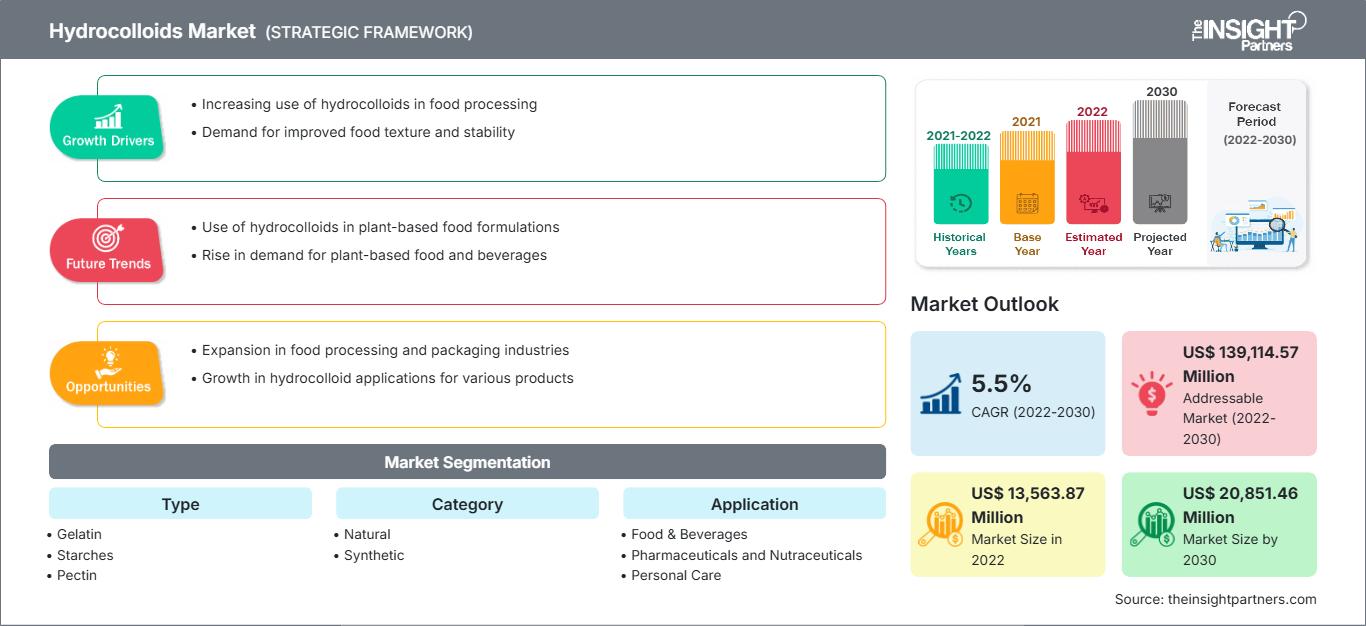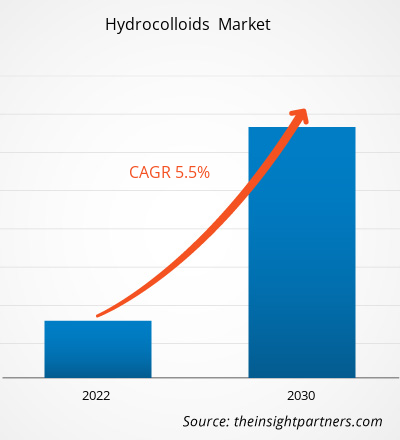[Research Report] The hydrocolloids market size is projected to grow from US$ 13,563.87 million in 2022 to US$ 20,851.46 million by 2030; the market is expected to register a CAGR of 5.5% from 2022 to 2030.
Market Insights and Analyst View:
Hydrocolloids are extracted from plants, algae, and seaweed. They can also be manufactured using microbial synthesis. These polymers possess excellent thickening, binding, and gelling abilities. Gelatin, pectin, agar, xanthan gum, carrageenan, gellan gum, alginates, guar gum, locust bean gum (LBG), modified starches, cellulose, chitin, and chitosan are various types of hydrocolloids used in food and beverages, pharmaceuticals, nutraceuticals, personal care products, animal feed and pet food, and other industrial products. The continuously flourishing food & beverages sector in the world due to increasing population, rising urban population, changing lifestyle, and hectic work schedule drives the demand for various food ingredients, including hydrocolloids, bolstering the hydrocolloids market growth.
Growth Drivers and Challenges:
Consumers are highly concerned about their diet, and they pay attention to product labels and additives used in processed foods and beverages. The popularity of organic and clean-label products is increasing owing to their perceived health benefits. They are free of pesticides, chemical fertilizers, and genetically modified organisms (GMOs), which increase their appeal among consumers who are ready to pay higher prices. Moreover, consumers increasingly prefer clean-label food products free of synthetic colors, flavors, and other additives. They also focus on holistic and conscious consumption choices made with ethically sourced additives. Thus, an upsurging demand for natural additives is expected to emerge as a new trend in the hydrocolloids market in the coming years.
Customize This Report To Suit Your Requirement
You will get customization on any report - free of charge - including parts of this report, or country-level analysis, Excel Data pack, as well as avail great offers and discounts for start-ups & universities
Hydrocolloids Market: Strategic Insights

-
Get Top Key Market Trends of this report.This FREE sample will include data analysis, ranging from market trends to estimates and forecasts.
Report Segmentation and Scope:
The global hydrocolloids market is segmented on the basis of type, category, application, and geography. Based on type, the market is segmented into gelatin, starches, pectin, xanthan gum, carrageenan, alginates, and others. The market, based on category, is bifurcated into natural and synthetic. In terms of application, the hydrocolloids market is categorized into food & beverages, pharmaceuticals and nutraceuticals, personal care, and other applications. The market for the food & beverages segment is further segmented into bakery and confectionery; dairy and frozen desserts; meat, poultry, and seafood; beverages; and others. By geography, the hydrocolloids market is broadly segmented into North America, Europe, Asia Pacific (APAC), the Middle East & Africa (MEA), and South & Central America. The market in North America is further segmented into the US, Canada, and Mexico. The European hydrocolloids market is subsegmented into Germany, France, the UK, Italy, Russia, and the Rest of Europe. The market in Asia Pacific is further segmented into China, India, Japan, Australia, South Korea, and the Rest of Asia Pacific. The hydrocolloids market in the MEA is subsegmented into South Africa, Saudi Arabia, the UAE, and the Rest of MEA. The market in South & Central America market is categorized into Brazil, Argentina, and the Rest of South & Central America
Segmental Analysis
Based on type, the gelatin segment held the largest share of the hydrocolloids market; the carrageenan segment is expected to record the fastest CAGR during 2022–2030. Carrageenan is obtained from red seaweed, and it possesses excellent gelling and thickening properties. Carrageenan has been gaining popularity due to the increasing economic significance and potential health benefits of red seaweed, and the widespread use of carrageenan and agar in food products, cosmetics, medicines, and dietary supplements. Thus, the rising demand for carrageenan is expected to benefit the hydrocolloids market.
Based on category, the natural segment held a larger share of the hydrocolloids market in 2022. The segment is expected to register a higher CAGR from 2022 to 2030. The demand for naturally sourced ingredients is on the rise due to the potential ill effects of synthetic/chemical food additives on consumers’ health. Consumers are increasingly focusing on product labels and prefer the products with transparent labels.
Regional Analysis:
Among all major regions, Asia Pacific dominated the hydrocolloids market in 2022. The market in this region was valued at US$ 5,036.62 million in 2022. North America is a second major contributor to the global market, holding approximately 27% market share. The US is a significant market for hydrocolloids due to rising demand for convenience food, in line with the fast lifestyle and ease provided by packaged food and beverages in terms of cooking and on-the-go consumption. Hydrocolloids are widely used in packaged/processed food and beverages as a thickening, gelling, and emulsifying agent. Moreover, hydrocolloids act as a stabilizing agent, extending the overall shelf life of the product.
Industry Developments and Future Opportunities:
Various initiatives taken by the key players operating in the hydrocolloids market are listed below:
- In February 2021, Jungbunzlauer, a Swiss company, launched high-acyl gellan gum under the brand “TayaGel.” This product is an outstanding stabilizer for various food products such as dairy-based beverages and dairy alternatives.
- In October 2021, Tilley Co. acquired Ingredient Solutions Inc., a specialty distributor of hydrocolloids. The acquisition will help the company expand its hydrocolloid portfolio.
Hydrocolloids
Hydrocolloids Market Regional InsightsThe regional trends and factors influencing the Hydrocolloids Market throughout the forecast period have been thoroughly explained by the analysts at The Insight Partners. This section also discusses Hydrocolloids Market segments and geography across North America, Europe, Asia Pacific, Middle East and Africa, and South and Central America.
Hydrocolloids Market Report Scope
| Report Attribute | Details |
|---|---|
| Market size in 2022 | US$ 13,563.87 Million |
| Market Size by 2030 | US$ 20,851.46 Million |
| Global CAGR (2022 - 2030) | 5.5% |
| Historical Data | 2021-2022 |
| Forecast period | 2022-2030 |
| Segments Covered |
By Type
|
| Regions and Countries Covered |
North America
|
| Market leaders and key company profiles |
|
Hydrocolloids Market Players Density: Understanding Its Impact on Business Dynamics
The Hydrocolloids Market is growing rapidly, driven by increasing end-user demand due to factors such as evolving consumer preferences, technological advancements, and greater awareness of the product's benefits. As demand rises, businesses are expanding their offerings, innovating to meet consumer needs, and capitalizing on emerging trends, which further fuels market growth.

- Get the Hydrocolloids Market top key players overview
COVID-19 Impact:
The COVID-19 pandemic affected almost all industries in various countries in North America, Europe, Asia Pacific (APAC), South & Central America (SAM), and the Middle East & Africa (MEA). Lockdowns, travel restrictions, and business shutdowns in these regions hampered the growth of the food & beverages and pharmaceuticals & nutraceuticals industries. The shutdown of manufacturing units disturbed global supply chains, manufacturing activities, delivery schedules, and essential and nonessential product sales. Various companies witnessed and announced delays in product deliveries, along with the projection of a slump in sales of their products in 2020. All these factors had a negative impact on the global hydrocolloids market.
The demand for natural and clean-label products increased dramatically during the COVID-19 pandemic as consumers perceive natural products to be healthier than conventional ones. This factor propelled the demand for hydrocolloids in the food & beverages sector. Also, the demand for personal care products with vegan, cruelty-free, natural, and herbal claims increased during the pandemic owing to increased sustainability concerns. This factor indicate strong growth potential for the natural hydrocolloids market in the personal care and cosmetic space. Further, in 2021, the governments of various countries announced relaxations in the restrictions such as lockdowns, trade barriers, and business shutdowns, which led to a recovery in the marketplace. Also, the manufacturers were permitted to operate with full employee strength, which helped them overcome the demand–supply gap.
Competitive Landscape and Key Companies:
The Top 10 companies operating in the global hydrocolloids market are Cargill Incorporated, ADM, Ingredion, DSM, J M Huber, Tate & Lyle Plc, Kerry Group Plc, Gelita AG, International Flavors & Fragrances Inc, and American International Foods Inc. These players focus on developing plant-based, natural, organic, and clean-label flavor masking ingredients, which is expected to open new growth opportunities in the coming years.
- Historical Analysis (2 Years), Base Year, Forecast (7 Years) with CAGR
- PEST and SWOT Analysis
- Market Size Value / Volume - Global, Regional, Country
- Industry and Competitive Landscape
- Excel Dataset
Recent Reports
Testimonials
Reason to Buy
- Informed Decision-Making
- Understanding Market Dynamics
- Competitive Analysis
- Identifying Emerging Markets
- Customer Insights
- Market Forecasts
- Risk Mitigation
- Boosting Operational Efficiency
- Strategic Planning
- Investment Justification
- Tracking Industry Innovations
- Aligning with Regulatory Trends





















 Get Free Sample For
Get Free Sample For